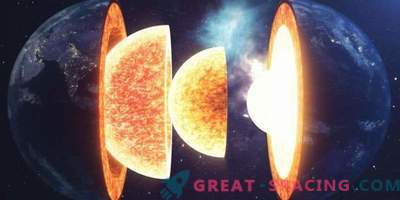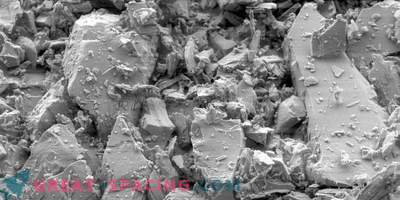
Mysterious droplets in the depths of the earth’s mantle can be minerals that have precipitated from the ancient ocean of magma created during the collision that gave rise to the moon. These drops, referred to as ultra-low speed zones, are located deep in the mantle, close to the Earth's core. They are known only because when seismic waves from earthquakes pass through them, the latter slow down. This suggests that these drops are somewhat different from other parts of the mantle.
New research indicates that droplets may be rich in iron mineral - magnesiovustit. If this is so, then their presence could hint at the former ocean of magma, which existed 4.5 billion years ago, when a huge cosmic rock crashed into our planet and broke off the material for the formation of the moon.
Fancy Drops
The mantle covers 2,900 km, and the drops reach 100 km in width. They manage to slow down passing seismic waves up to 30% -50%. To study the bizarre formations directly will not work, so scientists had to imitate the pressure of the deep mantle under the earth's surface. To find out if the properties of ultra-low velocity zones are observed in magnesioobrazite, the researchers used a small sample of the mineral, put it in a pressure chamber and squeezed it tightly using a pair of diamond anvils. The entire device in size fits easily in the palm of your hand. Researchers bombarded the sample with X-rays at different angles, and then measured the energy of X-rays coming out of the sample.
Under pressure
It turned out that high pressure changes everything. At atmospheric pressure, the outgoing waves from the sample are always the same. But with the boundary index of the mantle core, the direction of wave movement plays an important role. Depending on the type of passage, the speed can change by 60%. The transverse wave passes through the mineral at 3 km / s in one direction and a little more than 5 km / s in the other.
The fastest movement at atmospheric pressure (along the edge of the crystal structure) is the slowest movement of the waves. The fastest movement indicator is on the surface of the crystal. These differences are called anisotropies.
What does this mean for a real mantle? Anisotropy is also observed in it. Of course, no one can prove it directly, but speculation has arguments. If the theory of magma cooling is true and magnesiovustite is present in the mantle, then evidence of the ancient ocean of magma can be recorded. Now scientists are working with seismologists to test the occurrence of seismic waves and determine the relevance of their reactions with a laboratory experiment.











































